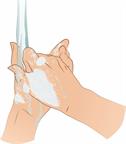ThisisPatientEngagementcontent
Hand Washing
Learn more about our Patient Engagement products now! Turn your patients into active participants in their healthcare by giving them easy access to the same evidence-based information you trust – but delivered in an easy-to-understand format.
Germs are all around us. They can be on surfaces, in the air, and even on your skin. Every day, your hands come into contact with germs. Many of these germs can make you and others sick. Washing your hands is an easy way to get rid of germs.
Wash your hands when they're dirty. Here's when to do it:
Before:
After:
When away from home:
Wash your hands after:Before and after:

 If you can't use soap and water, choose a hand sanitizer that:
If you can't use soap and water, choose a hand sanitizer that:Hand sanitizers shouldn't be used instead of soap and water when touching food.
This information is not intended to replace advice given to you by your health care provider. Make sure you discuss any questions you have with your health care provider.
Cookies are used by this site. To decline or learn more, visit our cookie notice.
Copyright © 2025 Elsevier, its licensors, and contributors. All rights are reserved, including those for text and data mining, AI training, and similar technologies.